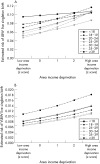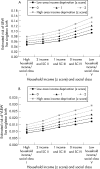Area deprivation, individual factors and low birth weight in England: is there evidence of an "area effect"?
- PMID: 17108301
- PMCID: PMC2465519
- DOI: 10.1136/jech.2005.042853
Area deprivation, individual factors and low birth weight in England: is there evidence of an "area effect"?
Abstract
Objective: To explore the relationship between low and very low birth weights, mother's age, individual socioeconomic status and area deprivation.
Design: Analysis of the incidence of low and very low birth weights by area deprivation, maternal age, social class of household and estimated income.
Setting: England 1996-2000.
Subjects: 2 894 440 singleton live births and the 10% sample of these births for which parents' individual-level socioeconomic measures were coded.
Results: Social class, estimated household income, lone-parenthood and mother's age were all associated with the risk of low and very low birth weight. Even when controlling for these individual level factors, area income deprivation was significantly associated with low and very low birth weight (p<0.00). For low birth weight there was a significant interaction between area income deprivation and mother's age. For very young mothers, the area effect was non-significant (p<0.37). For older mothers, particularly those aged 30-34 years, it was stronger (p<0.00). As a result, mothers aged <18 years, although at relatively high risk of low birth weight irrespective of area income deprivation, were actually at slightly lower risk than mothers aged >40 years in the most deprived areas.
Conclusions: For all but very young mothers, there seems to be a negative effect on birth weight from living in areas of income deprivation, whatever their individual circumstances.
Conflict of interest statement
Competing interests: None.
References
-
- Kuh D, Ben‐Shlomo Y.A life course approach to chronic disease epidemiology. 2nd edn. Oxford: Oxford University Press, 2004
-
- Wilcox A J. On the importance—and the unimportance—of birthweight. Int J Epidemiol 2001301233–1241. - PubMed
-
- Macfarlane A, Mugford M.Birth counts: statistics of pregnancy and childbirth. 2nd edn. London: The Stationery Office, 2000
-
- Macfarlane A, Stafford M, Moser K. Social inequalities. Chapter 8. In Office for National Statistics, eds. The health of children and young people London, Office for National Statistics 2004
Publication types
MeSH terms
LinkOut - more resources
Full Text Sources
Medical
Research Materials



